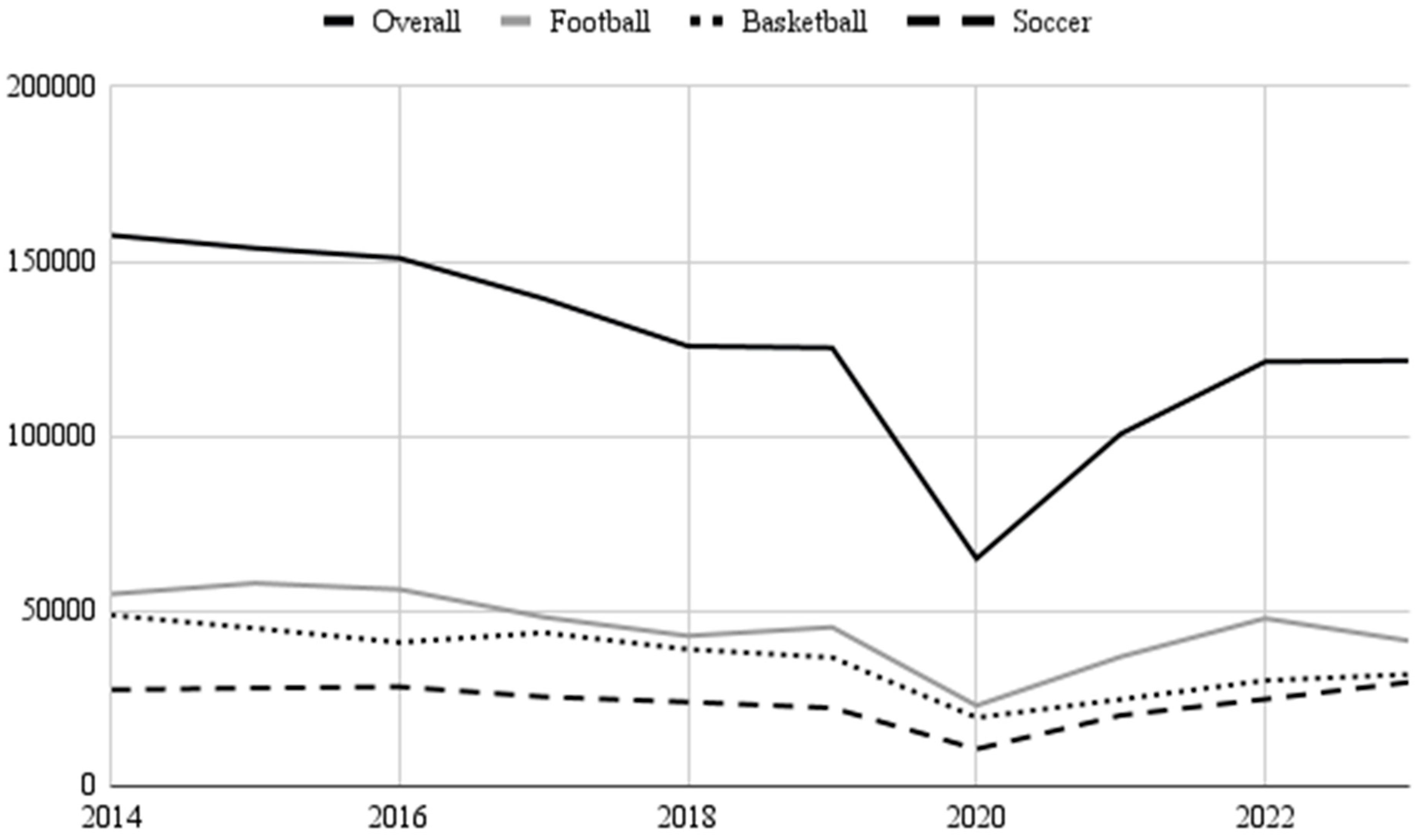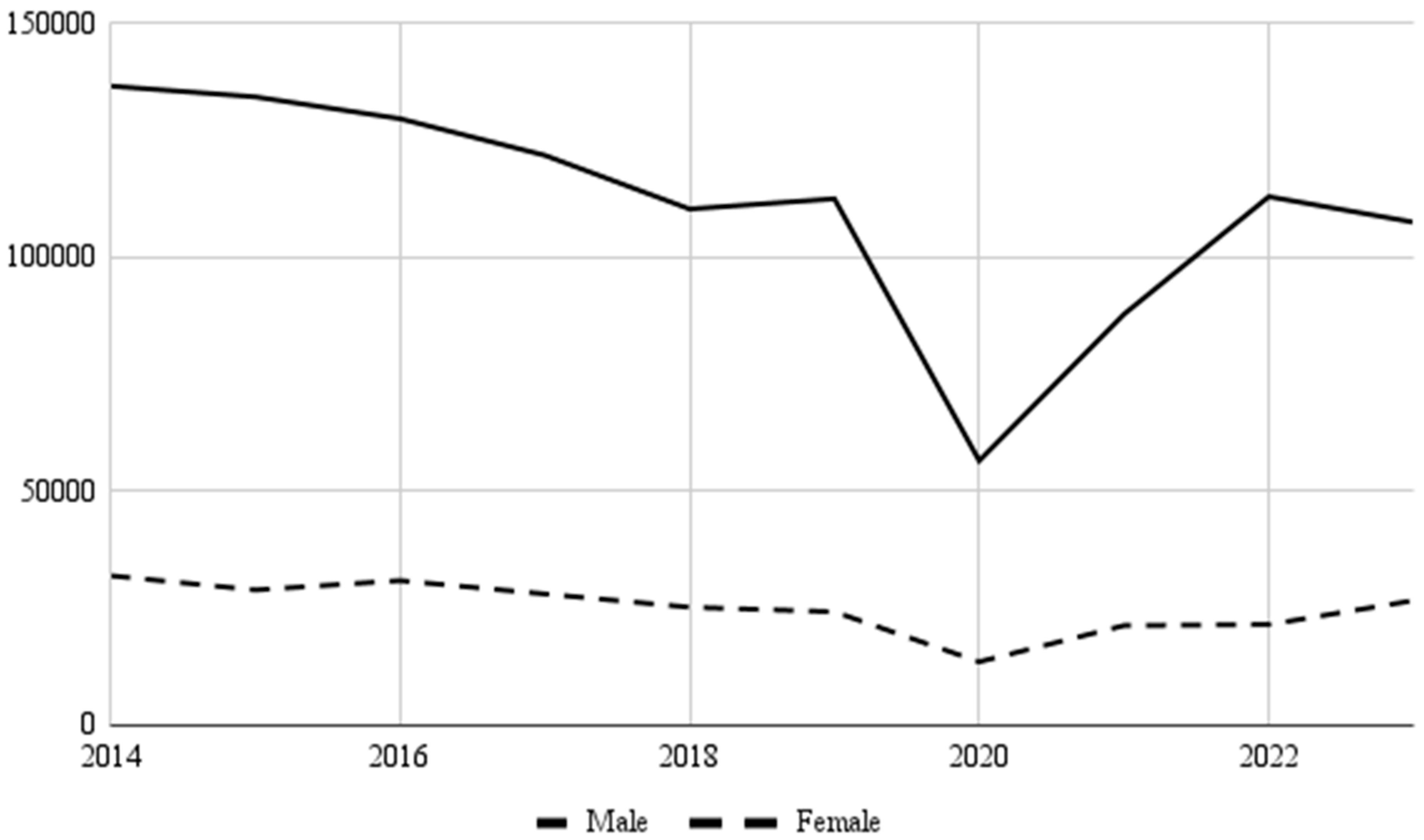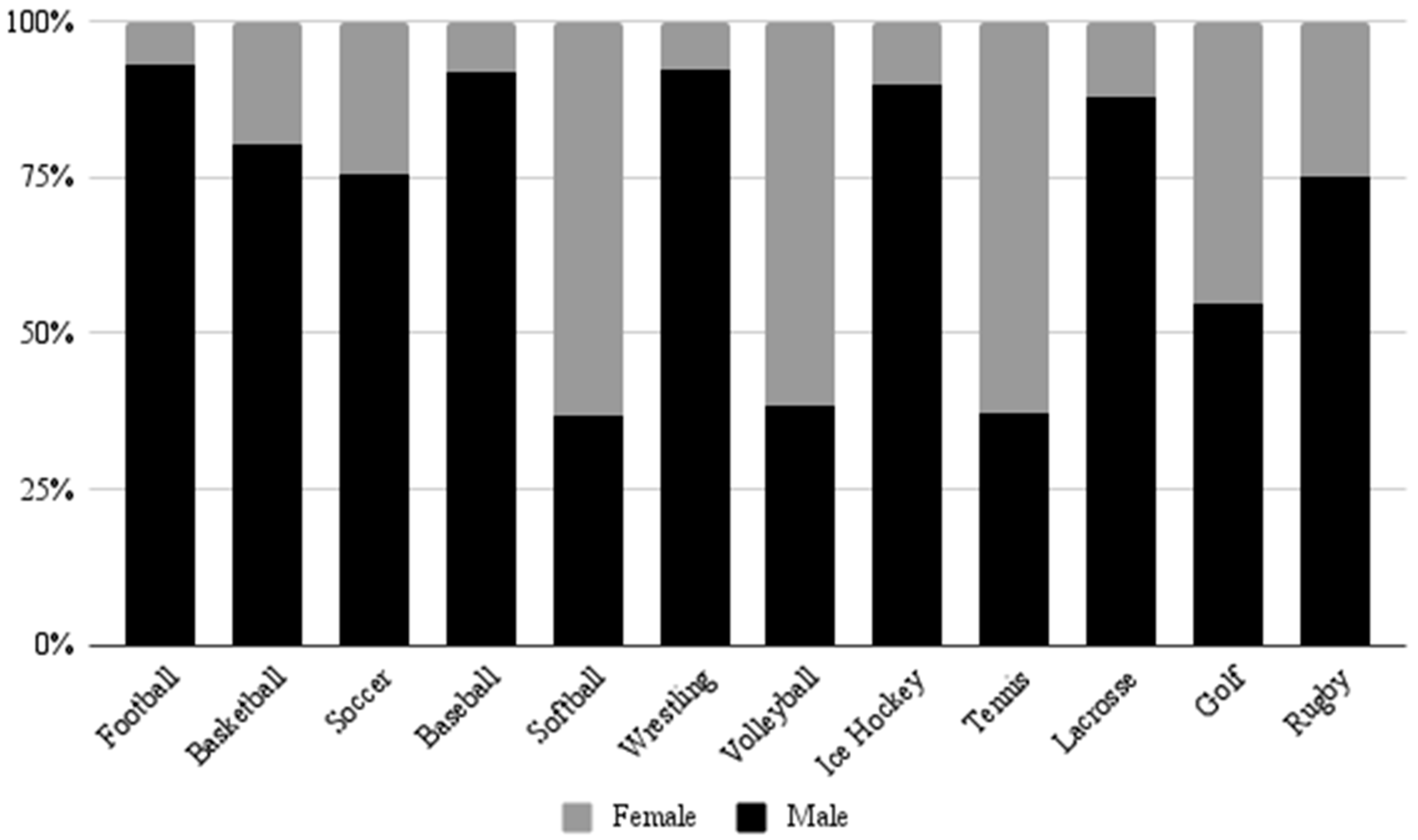Trends in Sports-Related Upper Extremity Injuries Presenting to United States Emergency Departments: A Retrospective Analysis of National Injury Data
Abstract
1. Introduction
2. Methods
2.1. Database
2.2. Data Extraction
2.3. Data Cleaning
2.4. Statistical Analysis
3. Results
4. Discussion
5. Limitations
6. Conclusions
Author Contributions
Funding
Institutional Review Board Statement
Informed Consent Statement
Data Availability Statement
Conflicts of Interest
Abbreviations
| ED | Emergency department |
| FOOSH | Fall on an outstretched hand |
| NCAA | National Collegiate Athletic Association |
| NEISS | National electronic injury surveillance system |
| NE | National estimate |
| NHANES | National Health and Nutrition Examination Survey |
| PIP | Proximal interphalangeal |
| UE | Upper extremity |
| US | United States |
References
- DeCastro, A. Common Upper-Extremity Injuries. Prim. Care Clin. Off. Pract. 2020, 47, 105–114. [Google Scholar] [CrossRef]
- Patel, D.S.; Statuta, S.M.; Ahmed, N. Common Fractures of the Radius and Ulna. Am. Fam. Physician 2021, 103, 345–354. [Google Scholar]
- Winston, M.J.; Weiland, A.J. Scaphoid Fractures in the Athlete. Curr. Rev. Musculoskelet. Med. 2017, 10, 38–44. [Google Scholar] [CrossRef]
- Zaremski, J.L.; Zeppieri, G., Jr.; Tripp, B.L. Sport Specialization and Overuse Injuries in Adolescent Throwing Athletes: A Narrative Review. J. Athl. Train. 2019, 54, 1030–1039. [Google Scholar] [CrossRef]
- Kocher, M.S.; Waters, P.M.; Micheli, L.J. Upper Extremity Injuries in the Paediatric Athlete. Sports Med. 2012, 30, 117–135. [Google Scholar] [CrossRef]
- Bélanger, M.; Townsend, N.; Foster, C. Age-Related Differences in Physical Activity Profiles of English Adults. Prev. Med. 2011, 52, 247–249. [Google Scholar] [CrossRef]
- Schroen, C.A.; Ranson, W.A.; Singh, P.; Li, T.; Patel, A.V.; Bernstein, J.; Shukla, D.R.; Parsons, B.O.; Flatow, E.L.; Cagle, P.J. Anatomic Total Shoulder Arthroplasty in the 7th Decade of Life Demonstrates Superior Long-Term Maintenance than in Older Patients. J. Orthop. 2025, 65, 57–63. [Google Scholar] [CrossRef] [PubMed]
- Carlisle, J.C.; Goldfarb, C.A.; Mall, N.; Powell, J.W.; Matava, M.J. Upper Extremity Injuries in the National Football League: Part II: Elbow, Forearm, and Wrist Injuries. Am. J. Sports Med. 2008, 36, 1945–1952. [Google Scholar] [CrossRef] [PubMed]
- Sims, L.A. Upper Extremity Injuries in Rock Climbers: Diagnosis and Management. J. Hand Surg. Am. 2022, 47, 662–672. [Google Scholar] [CrossRef] [PubMed]
- Matsumoto, K.; Miyamoto, K.; Sumi, H.; Sumi, Y.; Shimizu, K. Upper Extremity Injuries in Snowboarding and Skiing: A Comparative Study. Clin. J. Sport. Med. 2002, 12, 354–359. [Google Scholar] [CrossRef]
- Chung, K.C.; Lark, M.E. Upper Extremity Injuries in Tennis Players: Diagnosis, Treatment, and Management. Hand Clin. 2017, 33, 175–186. [Google Scholar] [CrossRef] [PubMed]
- Wolf, M.R.; Avery, D.; Wolf, J.M. Upper Extremity Injuries in Gymnasts. Hand Clin. 2017, 33, 187–197. [Google Scholar] [CrossRef] [PubMed]
- Mariscalco, M.W.; Saluan, P. Upper Extremity Injuries in the Adolescent Athlete. Sports Med. Arthrosc. Rev. 2011, 19, 17–26. [Google Scholar] [CrossRef]
- Ireland, M.L.; Hutchinson, M.R. Upper Extremity Injuries in Young Athletes. Clin. Sports Med. 1995, 14, 533–569. [Google Scholar] [CrossRef]
- Kong, H.; Feng, J.; McClellan, C.; Raney, E.; Foss, M.; Cowley, J.; Wick, J.M. Pediatric Orthopedic Injury Prevention for Team Sports Post COVID-19. J. Fam. Med. Prim. Care 2022, 11, 833–838. [Google Scholar] [CrossRef] [PubMed]
- Paoli, A.; Musumeci, G. Elite Athletes and COVID-19 Lockdown: Future Health Concerns for an Entire Sector. J. Funct. Morphol. Kinesiol. 2020, 5, 30. [Google Scholar] [CrossRef]
- Ladehoff, L.C.; Kuruvilla, D.; Coughlin, E.; Mhaskar, R.; Remaley, D.T. Epidemiology of American Football-Related Fractures in the United States 2002–2021. Orthop. J. Sports Med. 2024, 12, 23259671241259481. [Google Scholar] [CrossRef]
- Koehne, N.H.; Locke, A.R.; Yendluri, A.; Schwartz, L.B.; Namiri, N.K.; Li, X.; Galatz, L.M.; Parsons, B.O.; Kelly, J.D., 4th; Parisien, R.L. Sex and Age-Specific Analysis of Basketball-Related Shoulder Dislocations in the United States: A National Injury Data Review. J. Shoulder Elbow Surg. 2024, 34, 955–961. [Google Scholar] [CrossRef]
- Chevinsky, J.D.; Shah, N.V.; Tretiakov, M.; Aylyarov, A.; Penny, G.S.; Dekis, J.C.; Chorney, J.N.; Ahmed, N.; Sodhi, N.; Wilhelm, A.B.; et al. Demographics of Tennis-Related Injuries That Presented to Emergency Departments in the United States. Surg. Technol. Int. 2017, 31, 352–358. [Google Scholar]
- Football: Probability of Competing Beyond High School. Available online: https://www.ncaa.org/sports/2015/2/27/football-probability-of-competing-beyond-high-school.aspx (accessed on 19 February 2025).
- Estimated Probability of Competing in Professional Athletics. Available online: https://www.ncaa.org/sports/2015/3/6/estimated-probability-of-competing-in-professional-athletics.aspx (accessed on 19 February 2025).
- Ham, S.A.; Kruger, J.; Tudor-Locke, C. Participation by US Adults in Sports, Exercise, and Recreational Physical Activities. J. Phys. Act. Health 2009, 6, 6–14. [Google Scholar] [CrossRef]
- Stenner, B.J.; Buckley, J.D.; Mosewich, A.D. Reasons Why Older Adults Play Sport: A Systematic Review. J. Sport. Health Sci. 2020, 9, 530–541. [Google Scholar] [CrossRef]
- Mall, N.A.; Carlisle, J.C.; Matava, M.J.; Powell, J.W.; Goldfarb, C.A. Upper Extremity Injuries in the National Football League: Part I: Hand and Digital Injuries. Am. J. Sports Med. 2008, 36, 1938–1944. [Google Scholar] [CrossRef]
- Elzinga, K.E.; Chung, K.C. Finger Injuries in Football and Rugby. Hand Clin. 2017, 33, 149–160. [Google Scholar] [CrossRef]
- Netscher, D.T.; Pham, D.T.; Staines, K.G. Finger Injuries in Ball Sports. Hand Clin. 2017, 33, 119–139. [Google Scholar] [CrossRef] [PubMed]
- Obana, K.K.; Singh, P.; Namiri, N.K.; Levine, W.N.; Parsons, B.O.; Trofa, D.P.; Parisien, R.L. The Finger, Wrist, and Shoulder Are the Most Commonly Injured Areas in Youth Volleyball Players but the Incidence of Injuries Decreased Overall Between 2012 and 2022. Arthrosc. Sports Med. Rehabil. 2024, 6, 100862. [Google Scholar] [CrossRef] [PubMed]
- Lee, P.M.; Snyder, E.M.; Obana, K.K.; Trofa, D.; Lee, L.; You, J. Prevalence of Upper Extremity Volleyball Injuries Within Different Adult Age Groups: A Comprehensive Analysis of National Data From 2013–2022. Orthop. J. Sports Med. 2024, 12, 23259671241298586. [Google Scholar] [CrossRef] [PubMed]
- Snyder, E.M.; Obana, K.K.; Abdelaziz, A.; Parisien, R.L.; Ahmad, C.S.; Popkin, C.A.; Trofa, D.P. Decreasing Incidence of Youth Wrestling Injuries: A 10-Year Analysis of National Injury Data. Orthop. J. Sports Med. 2024, 12, 23259671241297988. [Google Scholar] [CrossRef]
- Bonza, J.E.; Fields, S.K.; Yard, E.E.; Dawn Comstock, R. Shoulder Injuries among United States High School Athletes during the 2005–2006 and 2006–2007 School Years. J. Athl. Train. 2009, 44, 76–83. [Google Scholar] [CrossRef]
- Powell, J.R.; Boltz, A.J.; Robison, H.J.; Morris, S.N.; Collins, C.L.; Chandran, A. Epidemiology of Injuries in National Collegiate Athletic Association Men’s Wrestling: 2014-2015 Through 2018–2019. J. Athl. Train. 2021, 56, 727–733. [Google Scholar] [CrossRef]
- Gardner, E.C.; Chan, W.W.; Sutton, K.M.; Blaine, T.A. Shoulder Injuries in Men’s Collegiate Lacrosse, 2004–2009. Am. J. Sports Med. 2016, 44, 2675–2681. [Google Scholar] [CrossRef]
- Hinton, R.Y.; Lincoln, A.E.; Almquist, J.L.; Douoguih, W.A.; Sharma, K.M. Epidemiology of Lacrosse Injuries in High School-Aged Girls and Boys: A 3-Year Prospective Study. Am. J. Sports Med. 2005, 33, 1305–1314. [Google Scholar] [CrossRef] [PubMed]
- Willigenburg, N.W.; Borchers, J.R.; Quincy, R.; Kaeding, C.C.; Hewett, T.E. Comparison of Injuries in American Collegiate Football and Club Rugby: A Prospective Cohort Study. Am. J. Sports Med. 2016, 44, 753–760. [Google Scholar] [CrossRef] [PubMed]
- Usman, J.; McIntosh, A.S.; Quarrie, K.; Targett, S. Shoulder Injuries in Elite Rugby Union Football Matches: Epidemiology and Mechanisms. J. Sci. Med. Sport. 2015, 18, 529–533. [Google Scholar] [CrossRef]
- Helgeson, K.; Stoneman, P. Shoulder Injuries in Rugby Players: Mechanisms, Examination, and Rehabilitation. Phys. Ther. Sport. 2014, 15, 218–227. [Google Scholar] [CrossRef]
- Avery, D.M., 3rd; Rodner, C.M.; Edgar, C.M. Sports-Related Wrist and Hand Injuries: A Review. J. Orthop. Surg. Res. 2016, 11, 99. [Google Scholar] [CrossRef] [PubMed]
- Schroen, C.A.; Duey, A.H.; Nasser, P.; Laudier, D.; Cagle, P.J.; Hausman, M.R. What Is the Sequence of Mechanical and Structural Failure during Stretch Injury in the Rat Median Nerve? The Neuroclasis Classification. Clin. Orthop. Relat. Res. 2025, 483, 1142–1158. [Google Scholar] [CrossRef]
- Rafi, B.M.; Tiwari, V. Forearm Fractures. In StatPearls; StatPearls Publishing: Treasure Island, FL, USA, 2025. [Google Scholar]




| Age Group | ||||||||
|---|---|---|---|---|---|---|---|---|
| Child (0–10) | Middle School (11–13) | High School (14–18) | College (19–23) | Young Adult (24–30) | Adult (31–50) | Late Adult (51–64) | Senior (65+) | |
| Top Three Sports | 1. Football (36.0%) | 1. Football (38.7%) | 1. Football (37.6%) | 1. Basketball (41.5%) | 1. Basketball (33.4%) | 1. Basketball (29.3%) | 1. Tennis (26.5%) | 1. Tennis (43.3%) |
| 2. Bicycling (30.0%) | 2. Basketball (27.1%) | 2. Basketball (27.7%) | 2. Football (23.3%) | 2. Football (23.3%) | 2. Soccer (18.5%) | 2. Basketball (20.4%) | 2. Golf (23.5%) | |
| 3. Basketball (21.4%) | 3. Soccer (18.2%) | 3. Soccer (14.1%) | 3. Soccer (17.0%) | 3. Soccer (17.0%) | 3. Football (17.2%) | 3. Baseball (11.3%) | 3. Softball (9.5%) | |
| Football | Basketball | Soccer | Baseball | Softball | Ice Hockey | Tennis | Golf | Wrestling | Volleyball | Rugby | Lacrosse |
|---|---|---|---|---|---|---|---|---|---|---|---|
| 1. Finger (35.6%) | 1. Finger (45.2%) | 1. Wrist (31.9%) | 1. Finger (37.7%) | 1. Finger (47.1%) | 1. Shoulder (34.2%) | 1. Wrist (45.6%) | 1. Lower arm (24.7%) | 1. Shoulder (99.1%) | 1. Lower arm (62.2%) | 1. Shoulder (46.5%) | 1. Shoulder (71.5%) |
| 2. Shoulder (18.7%) | 2. Wrist (19.1%) | 2. Lower arm (25.0%) | 2. Lower arm (16.7%) | 2. Wrist (16.7%) | 2. Wrist (26.2%) | 2. Lower arm (25.1%) | 2. Wrist (23.7%) | 2. Elbow (0.9%) | 2. Elbow (15.6%) | 2. Finger (24.7%) | 2. Lower arm (17.3%) |
| 3. Lower arm (16.6%) | 3. Lower arm (14.3%) | 3. Shoulder (16.3%) | 3. Wrist (16.4%) | 3. Hand (14.6%) | 3. Lower arm (16.3%) | 3. Shoulder (8.2%) | 3. Upper arm (14.4%) | 3. N/A | 3. Shoulder (11.1%) | 3. Wrist (12%) | 3. Elbow (11%) |
Disclaimer/Publisher’s Note: The statements, opinions and data contained in all publications are solely those of the individual author(s) and contributor(s) and not of MDPI and/or the editor(s). MDPI and/or the editor(s) disclaim responsibility for any injury to people or property resulting from any ideas, methods, instructions or products referred to in the content. |
© 2025 by the authors. Licensee MDPI, Basel, Switzerland. This article is an open access article distributed under the terms and conditions of the Creative Commons Attribution (CC BY) license (https://creativecommons.org/licenses/by/4.0/).
Share and Cite
Ramey, M.D.; Swaminathan, S.J.; Locke, A.R.; Koehne, N.H.; Schroen, C.A.; Swaminathan, V.G.; Corvi, J.J.; Capotosto, S.; Cagle, P.J.; Hausman, M.R. Trends in Sports-Related Upper Extremity Injuries Presenting to United States Emergency Departments: A Retrospective Analysis of National Injury Data. J. Clin. Med. 2025, 14, 6208. https://doi.org/10.3390/jcm14176208
Ramey MD, Swaminathan SJ, Locke AR, Koehne NH, Schroen CA, Swaminathan VG, Corvi JJ, Capotosto S, Cagle PJ, Hausman MR. Trends in Sports-Related Upper Extremity Injuries Presenting to United States Emergency Departments: A Retrospective Analysis of National Injury Data. Journal of Clinical Medicine. 2025; 14(17):6208. https://doi.org/10.3390/jcm14176208
Chicago/Turabian StyleRamey, Matthew D., Srivatsan J. Swaminathan, Auston R. Locke, Niklas H. Koehne, Christoph A. Schroen, Visweshwar G. Swaminathan, John J. Corvi, Salvatore Capotosto, Paul J. Cagle, and Michael R. Hausman. 2025. "Trends in Sports-Related Upper Extremity Injuries Presenting to United States Emergency Departments: A Retrospective Analysis of National Injury Data" Journal of Clinical Medicine 14, no. 17: 6208. https://doi.org/10.3390/jcm14176208
APA StyleRamey, M. D., Swaminathan, S. J., Locke, A. R., Koehne, N. H., Schroen, C. A., Swaminathan, V. G., Corvi, J. J., Capotosto, S., Cagle, P. J., & Hausman, M. R. (2025). Trends in Sports-Related Upper Extremity Injuries Presenting to United States Emergency Departments: A Retrospective Analysis of National Injury Data. Journal of Clinical Medicine, 14(17), 6208. https://doi.org/10.3390/jcm14176208






